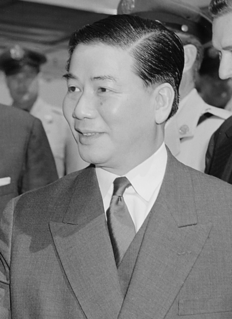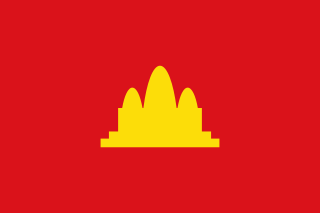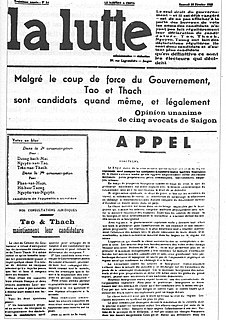Related Research Articles

French Indochina, officially known as the Indochinese Union and after 1947 as the Indochinese Federation, was a grouping of French colonial territories in Southeast Asia until its demise in 1954. It comprised Cambodia, Laos, the Chinese territory of Guangzhouwan, and the Vietnamese regions of Tonkin in the north, Annam in the centre, and Cochinchina in the south. The capital for most of its history (1902–45) was Hanoi; Saigon was the capital from 1887 to 1902 and again from 1945 to 1954.

Ngô Đình Diệm was a Vietnamese politician. He was the final prime minister of the State of Vietnam (1954–1955), and then served as President of South Vietnam from 1955 until he was captured and assassinated during the 1963 military coup.

Annam, or Trung Kỳ (中圻), was a French protectorate encompassing Central Vietnam. Before the protectorate's establishment, the name Annam was used in the West to refer to Vietnam as a whole; Vietnamese people were referred to as Annamites. The protectorate of Annam became a part of French Indochina in 1887, along with two other Vietnamese regions, Cochinchina in the South and Tonkin in the North. The region had a dual system of French and Vietnamese administration. The Nguyễn Dynasty still nominally ruled Annam, with a puppet emperor residing in Huế. In 1948, the protectorate was merged in the Provisional Central Government of Vietnam, which was replaced the next year by the newly established State of Vietnam. The region was divided between communist North Vietnam and anti-communist South Vietnam under the terms of the Geneva Accord of 1954.

The Nguyễn dynasty was the last Vietnamese dynasty, which ruled the unified Vietnamese state largely independently from 1802 to 1884. During its existence, the empire expanded into modern-day southern Vietnam, Cambodia, and Laos through a continuation of the centuries-long Nam tiến and Siamese–Vietnamese wars. After 1883, the Nguyễn emperors ruled nominally as heads of state of the French protectorates of Annam and Tonkin until the final months of WWII; they later nominally ruled over the Empire of Vietnam until the Japanese surrender.
The governments of the Thirteen Colonies of British America developed in the 17th and 18th centuries under the influence of the British constitution. After the Thirteen Colonies had become the United States, the experience under colonial rule would inform and shape the new state constitutions and, ultimately, the United States Constitution.

The Communist Party of Vietnam (CPV), also known as the Vietnamese Communist Party (VCP), is the founding and sole legal party of the Socialist Republic of Vietnam. Founded in 1930, the CPV became the ruling party of North Vietnam in 1954 and then all of Vietnam in 1976 after seizing power in South Vietnam. Although it nominally exists alongside the Vietnamese Fatherland Front, it maintains a unitary government and has centralized control over the state, military, and media. The supremacy of the CPV is guaranteed by Article 4 of the national constitution. The Vietnamese public generally refer to the CPV as simply "the Party" or "our Party".

Tạ Thu Thâu (1906–1945) in the 1930s was the principal representative of Trotskyism in Vietnam and, in colonial Cochinchina, of left opposition to the Indochinese Communist Party (PCI) of Nguyen Ai Quoc. He was executed by the Viet Minh in September 1945.

The Vietnamese people or Kinh people are a Southeast Asian ethnic group originally native to modern-day Northern Vietnam and Southern China. The native language is Vietnamese, the most widely spoken Austroasiatic language.

The Khmer Issarak was a "loosely structured" anti-French and anti-colonial independence movement. Besides, the movement was labelled as “amorphous”. The Issarak was formed around 1945 and composed of several factions each with its own leader. Most of the Issarak bands fought actively between the end of the Second World War in 1945 and Cambodia’s independence in 1953. Initial objectives of the Khmer Issarak was to fight against the French in order to gain independence. Later, overthrowing the Cambodian government became some Issarak bands' agenda. Moreover, the term Issarak originally referred to non-communist, but in the early 1950s the Việt Minh guided-guerrillas called themselves Issaraks for the sake of unifying other non-communist forces.

French Cochinchina was a colony of French Indochina, encompassing the whole region of Lower Cochinchina or Southern Vietnam from 1862 to 1946. The French operated a plantation economy whose primary strategic product was rubber.

The Việt Nam Quốc Dân Đảng, abbreviated VNQDĐ or Việt Quốc, was a nationalist and democratic socialist political party that sought independence from French colonial rule in Vietnam during the early 20th century. Its origins lie in a group of young Hanoi-based intellectuals who began publishing revolutionary material in the mid-1920s. In 1927, after the publishing house failed because of French harassment and censorship, the VNQDĐ was formed under the leadership of Nguyễn Thái Học. Modelling itself on the Kuomintang of Nationalist China the VNQDĐ gained a following among northerners, particularly teachers and intellectuals. The party, which was less successful among peasants and industrial workers, was organised in small clandestine cells.

Trotskyism in Vietnam was represented by those who, in left opposition to the Indochinese Communist Party (PCI) of Nguyen Ai Quoc, identified with the call by Leon Trotsky to re-found "vanguard parties of proletariat" on principles of "proletarian internationalism" and of "permanent revolution". Active in the 1930s in organising the Saigon waterfront, industry and transport, Trotskyists presented a significant challenge to the Moscow-aligned party in Cochinchina. Following the September 1945 Saigon uprising against the restoration of French colonial rule, Vietnamese Trotskyists were systematically hunted down and eliminated by both the French Sûreté and the Communist-front Viet Minh.

Trần Trọng Kim, courtesy name Lệ Thần, was a Vietnamese scholar and politician who served as the Prime Minister of the short-lived Empire of Vietnam, a state established with the support of Imperial Japan in 1945 after Japan had seized direct control of Vietnam from the Vichy French colonial forces during the Second World War. He was an uncle of Bui Diem.
Anarchism in Vietnam as a political movement started in the early twentieth century, as Vietnamese radicals became exposed to strands of anarchism in Japan, China and France. Its most recognizable proponents were Phan Bội Châu and Nguyễn An Ninh.

Relations between Vietnam and China and have been back and forth for thousands of years. Despite their Sinospheric and socialist background, centuries of conquest by modern China's imperial predecessor have made Vietnam wary of the Chinese government. Although China assisted North Vietnam during the Vietnam War, relations between the two nations soured following Vietnam's reunification in 1975. The root cause was the Vietnamese ouster of the Khmer Rouge, which had become genocidal, from power in Cambodia, a party that China had propped up. China invaded Vietnam in 1979, beginning the Sino-Vietnamese War. Cross-border raids and skirmishes ensued, in which China and Vietnam fought a prolonged border war from 1979 to 1990. Both sides have since worked to improve their diplomatic and economic ties, although the two countries remain in dispute over political and territorial issues in the South China Sea. China and Vietnam share a 1,281 kilometres (796 mi) border as well. In 2014, a survey conducted by the Pew Research Center showed 84% of Vietnamese were concerned that disputes relating to the South China Sea could lead to military conflict. However, the two countries have been striving for restraint as well as present and future stability. The two countries' political parties, although having faced a number of concerns, have since maintained socialist ties.
The Bombardment of Tourane was a naval incident that took place during the short reign of the Vietnamese emperor Thiệu Trị (1841–47), which saw a considerable worsening of relations between France and Vietnam. The French warships Gloire and Victorieuse, which had been sent to Tourane to negotiate for the release of two French Catholic missionaries, were attacked by several Vietnamese vessels. The two French ships fought back, sinking four Vietnamese corvettes, badly damaging a fifth, and inflicting just under 230 casualties. In response to this and other provocations, the French eventually decided to intervene actively in Vietnam, and a decade later launched the Cochinchina Campaign (1858–62), which inaugurated the period of French colonial rule in Vietnam.

La Lutte was a left-wing paper published in Saigon, French-colonial Cochinchina, in the 1930s. It was launched ahead of the April–May 1933 Saigon municipal council election as a joint organ of the Indochinese Communist Party (PCI) and a grouping of Trotskyists and others who agreed to run a joint "Workers' slate" of candidates for the polls. This kind of cooperation between Trotskyists and Comintern-linked communists was a phenomenon unique to Vietnam. The editorial line of La Lutte avoided criticism of the USSR while supporting the demands of workers and peasants without regard to faction The supporters of La Lutte were known as lutteurs.

Phan Văn Hùm was a Vietnamese journalist, philosopher and revolutionary who, from 1930, participated in the Trotskyist left opposition to the Communist Party of Nguyen Ai Quoc.
Colonial Council elections were held in French Cochinchina on 16 April 1939.

Tonkin, or Bắc Kỳ (北圻), was a French protectorate encompassing modern Northern Vietnam. Like the French protectorate of Annam, Tonkin was still nominally ruled by the Nguyễn dynasty, but in 1886, the French separated Tonkin from the Nguyễn imperial court in Huế by establishing the office of "Viceroy". However, on 26 July 1897, the position of Viceroy was abolished, officially making the French Resident-Superior of Tonkin both the representative of the French colonial administration and the Nguyễn dynasty court in Huế, giving him the power to appoint local mandarins. In 1887, Tonkin became a part of the Union of Indochina.
References
- ↑ Justin Corfield (2014) Historical Dictionary of Ho Chi Minh City, Anthem Press, pxxi
- ↑ Paul H. Kratoska (2001) South East Asia, Colonial History: High imperialism (1890s-1930s), Taylor & Francis, p311
- ↑ Robert Jackson Alexander (1991) International Trotskyism, 1929-1985: A Documented Analysis of the Movement, Duke University Press, 1 Jan 1991, p962
- ↑ K W Taylor (2013) A History of the Vietnamese, Cambridge University Press, p515